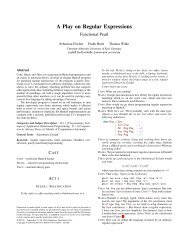What Every Programmer Should Know About Memory
What Every Programmer Should Know About Memory
What Every Programmer Should Know About Memory
You also want an ePaper? Increase the reach of your titles
YUMPU automatically turns print PDFs into web optimized ePapers that Google loves.
AMD’s Pacifica extension introduced the ASID to avoid<br />
TLB flushes on each entry. The number of bits for the<br />
ASID is one in the initial release of the processor extensions;<br />
this is just enough to differentiate VMM and guest<br />
OS. Intel has virtual processor IDs (VPIDs) which serve<br />
the same purpose, only there are more of them. But the<br />
VPID is fixed for each guest domain and therefore it cannot<br />
be used to mark separate processes and avoid TLB<br />
flushes at that level, too.<br />
The amount of work needed for each address space modification<br />
is one problem with virtualized OSes. There<br />
is another problem inherent in VMM-based virtualization,<br />
though: there is no way around having two layers<br />
of memory handling. But memory handling is hard (especially<br />
when taking complications like NUMA into account,<br />
see section 5). The Xen approach of using a separate<br />
VMM makes optimal (or even good) handling hard<br />
since all the complications of a memory management implementation,<br />
including “trivial” things like discovery of<br />
memory regions, must be duplicated in the VMM. The<br />
OSes have fully-fledged and optimized implementations;<br />
one really wants to avoid duplicating them.<br />
Guest Kernel<br />
Userlevel<br />
Process KVM VMM<br />
Linux Kernel<br />
Guest Kernel<br />
KVM VMM<br />
Figure 4.5: KVM Virtualization Model<br />
This is why carrying the VMM/Dom0 model to its conclusion<br />
is such an attractive alternative. Figure 4.5 shows<br />
how the KVM Linux kernel extensions try to solve the<br />
problem. There is no separate VMM running directly<br />
on the hardware and controlling all the guests; instead, a<br />
normal Linux kernel takes over this functionality. This<br />
means the complete and sophisticated memory handling<br />
functionality in the Linux kernel is used to manage the<br />
memory of the system. Guest domains run alongside<br />
the normal user-level processes in what the creators call<br />
“guest mode”. The virtualization functionality, para- or<br />
full virtualization, is controlled by the KVM VMM. This<br />
is just another userlevel process which happens to control<br />
a guest domain using the special KVM device the kernel<br />
implements.<br />
The benefit of this model over the separate VMM of the<br />
Xen model is that, even though there are still two memory<br />
handlers at work when guest OSes are used, there<br />
only needs to be one implementation, that in the Linux<br />
kernel. It is not necessary to duplicate the same functionality<br />
in another piece of code like the Xen VMM. This<br />
leads to less work, fewer bugs, and, perhaps, less friction<br />
where the two memory handlers touch since the memory<br />
handler in a Linux guest makes the same assumptions as<br />
the memory handler in the outer Linux kernel which runs<br />
on the bare hardware.<br />
Overall, programmers must be aware that, with virtualization<br />
used, the cost of cache misses (instruction, data,<br />
or TLB) is even higher than without virtualization. Any<br />
optimization which reduces this work will pay off even<br />
more in virtualized environments. Processor designers<br />
will, over time, reduce the difference more and more<br />
through technologies like EPT and NPT but it will never<br />
completely go away.<br />
42 Version 1.0 <strong>What</strong> <strong>Every</strong> <strong>Programmer</strong> <strong>Should</strong> <strong>Know</strong> <strong>About</strong> <strong>Memory</strong>



